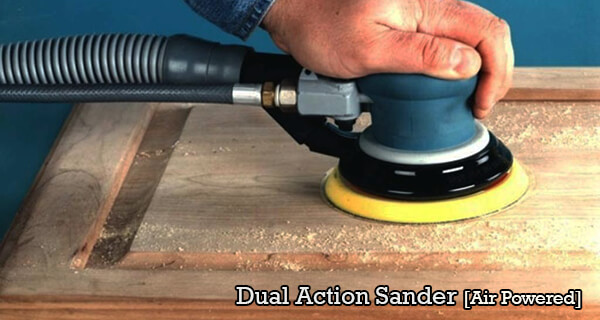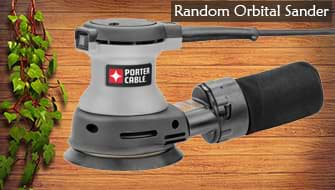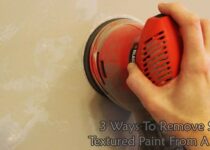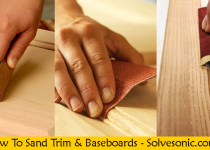DA Sander Vs Random Orbital Sander – Differences
A sander is a tool that you can’t imagine to finish your job without it. There are many types of sanders to do different kinds of sanding. Here, we’ll talk about DA sander vs Random orbital sander, and these two are two common sanders in the community.

That’s why a dual-action sander vs. random orbital sander comparison comes to our mind. With not much knowledge of sanding, we become eager to know which one is the best. But we need to understand that you can’t fall all types of sanding in one category.
That’s why there are different sanders for different jobs, and every tool has its merits and demerits. So, let’s get started with a little bit introduction of both sander types and try to know their differences bearing in mind that different use cases make a tool good or bad.
Table of Contents:=>
Comparison Table:
Features of => | Dual Action Sander | Random Orbital Sander |
Action Mechanism | Combines rotary and orbital actions, providing a dual-motion sanding effect. | Uses only random orbital motion, moving in both circles and ellipses for even sanding. |
Primary Use | Ideal for both aggressive material removal and fine finishing due to its dual-action. | Best suited for fine finishing work, smooth sanding, and light material removal. |
Control and Versatility | Offers more control over different sanding tasks due to dual-action mode. | Easier to handle for beginners, but not as versatile for aggressive tasks. |
Aggressiveness | Can be more aggressive when switched to rotary-only mode, making it suitable for heavier tasks. | Less aggressive, primarily focused on smoother finishes and less material removal. |
Vibration Level | Tends to produce more vibration, especially in rotary mode, which may cause fatigue over time. | Produces less vibration, making it more comfortable for extended use. |
Finish Quality | Provides high-quality finishes due to the combination of rotary and orbital movements. | Delivers a consistent, smooth finish, especially on wood and painted surfaces. |
Power Requirement | Often requires more power due to dual-action capability. | Typically uses less power and is more energy-efficient. |
Dust Collection | Usually equipped with decent dust collection systems, though dust control can vary. | Often comes with efficient dust collection, reducing airborne particles effectively. |
Weight and Size | Usually larger and heavier, making it slightly more challenging to maneuver for extended periods. | Generally smaller, lighter, and easier to maneuver, even in tight spaces. |
Price | Typically more expensive due to the dual-action feature and versatility. | Usually more affordable, making it a popular choice for DIYers and hobbyists. |
Best For | Professionals and advanced users needing versatility for a range of tasks (from heavy sanding to polishing). | DIY enthusiasts and hobbyists focused on achieving smooth finishes on wood and other materials. |
What is a Dual Action Sander?
You might be familiar with a belt sander or a disc sander. Both belt sanders and disk sanders have advantages and disadvantages. To get the advantages of both sanders, we need something hybrid called a dual-action sander. The motion of this device can be guessed from its name.

The dual action means it has two motions. One of those includes continuous moving of forward and backward, and another one includes a little bit of rotary motion. That’s how you get both the motions and advantages of a belt sander and a disc sander.
Pros:
- moving forward and backward
- Air Powered or Electric
- includes some rotary motion
- DA Sanders is designed to produce fine finishes on different materials such as metal, fiberglass, wood, and more

What is a Random Orbital Sander?

Orbital sanders are fundamental tools for sanding. People use it in different projects because of its ease of use. You can sand corners and use any sanding paper to do the sanding. But this is not a powerful tool to remove much material.
That’s where random orbital sander comes into action. Random orbital sanders are the best to remove a lot of materials quickly and don’t leave sanding marks. It has a disk-shaped sanding pad that spins as well as rotates in a tiny circular path. It’s like the motion of the earth. However, keep in mind that its path is not uniform and gives you a random oscillation.

Differences Between a DA Sander vs Random Orbital Sander:
Though DA sanders and RO sanders are great sanders and sands without leaving a mark, there are a few differences between them. We found out that the handle size, operability, sanding path, aggressiveness, and use cases are the main differences. Let’s get into the details of random orbital vs dual action sander.
Handle Size
Generally, the DA sanders come with palm-sized handles, and the RO sanders come with large handles. But the opposite can be true for different models.
The difference can be seen for general handle sizes. With different handle sizes, it can affect your operability. Let’s talk about that in the next point.
Operability
Operability is an important issue when it comes to sanding. Depending on your skill and tool handling capability, the quality of the sanding is dependable.
For some jobs, palm-sized tools seem a good option for better control. On the other hand, sometimes, large handles can serve you better for fine finishing. More details fall on the use-case point that you’ll find scrolling down.
Sanding Path
This is a point to see a clear difference between a DA sander and an RO sander. The sanding path of a DA sander is defined. It means that the path follows a pattern, and it passes the same route over and over again. But the RO sander doesn’t cross the same path. That’s why its name is random orbital.
For RO sanders, you’ll see the random motions and a path like the earth’s orbital movement.
Aggressiveness
Aggressiveness indicates how much material a sander can remove in a short time. For different jobs, the requirement for the level of aggressiveness is different. Here in our Random Orbital vs DA Sanders debate, DA Sanders are more aggressive than the other one.
To cover large areas and have sanding capability for multiple layers, dual-action sanders are your only option. But for other light-finishing jobs and cover corners more effectively, random orbital sanders will be your best friends.
Overall Finish
The overall sanding finish is different for a DA sander and an RO sander. Just above the sanding pad, the DA sander features a weight that can be locked or unlocked. In locked mode, you get to remove more material much more quickly. This is not a feature of a random orbital sander. So, you’ll see a difference in the performance of these two sander types.
Use Cases
Both sander types have more aggressive and less aggressive features. However, due to their motion differences, they are used in different fields. A random orbital sander is preferred for works that include sanding the wood stock. It also is used for big jobs like wooden floors.
However, dual-action sanders are preferred in auto body repair jobs. It’s because they don’t leave any scratch marks and can be controlled more precisely.
Final Verdict
After knowing all about DA sander vs. random orbital, we can tell both are powerful tools and are perfect for separate use cases. But dual-action sanders are indeed more powerful and aggressive than random orbital sanders. Both have speed controls so that you can get your desired finish. In the end, we recommend the dual-action sander for its precise handling capability, versatile usability, and scratch-free sanding feature. Choose the best one that fits the most for your situation and has the finest finish.
Last Updated on October 1, 2024 by Rogers Weber
[As an Amazon Associate I earn from qualifying purchases.]



Thanks for the info, but I’m still frustrated. I still do NOT know what equipment I need in order to use my new DA sander. It did NOT come with a hose. Do I need some kind of air compressor just to use my sander? It is starting to sound like more trouble than it is worth. Even in the little booklet that came with the sander, it says NOTHING about what else I need in order to use it. Typical engineers, don’t consider the importance of communication. Companies who want to sell accessories to tools should pay more attention.
To Margaret Warren, typically, DA sanders are air powered, meaning you’ll likely need a (bigger size) air compressor, air hose, and air fittings to connect it all together. Go to Lowes or a Ace Hardware and ask them, they’ll set you up; or go to an auto body/auto paint shop and ask them, they use DA sanders every day.
For the cost of everything you need, plus the cost to pay someone to fix your new mess it would be cheaper to hire
There are two types of DA sanders, electric and air powered, same holds true for Random Orbital Sanders. Margaret above needs to identify which sander she has and if it’s air powered, she’ll need to configure the connection to her air compressor.